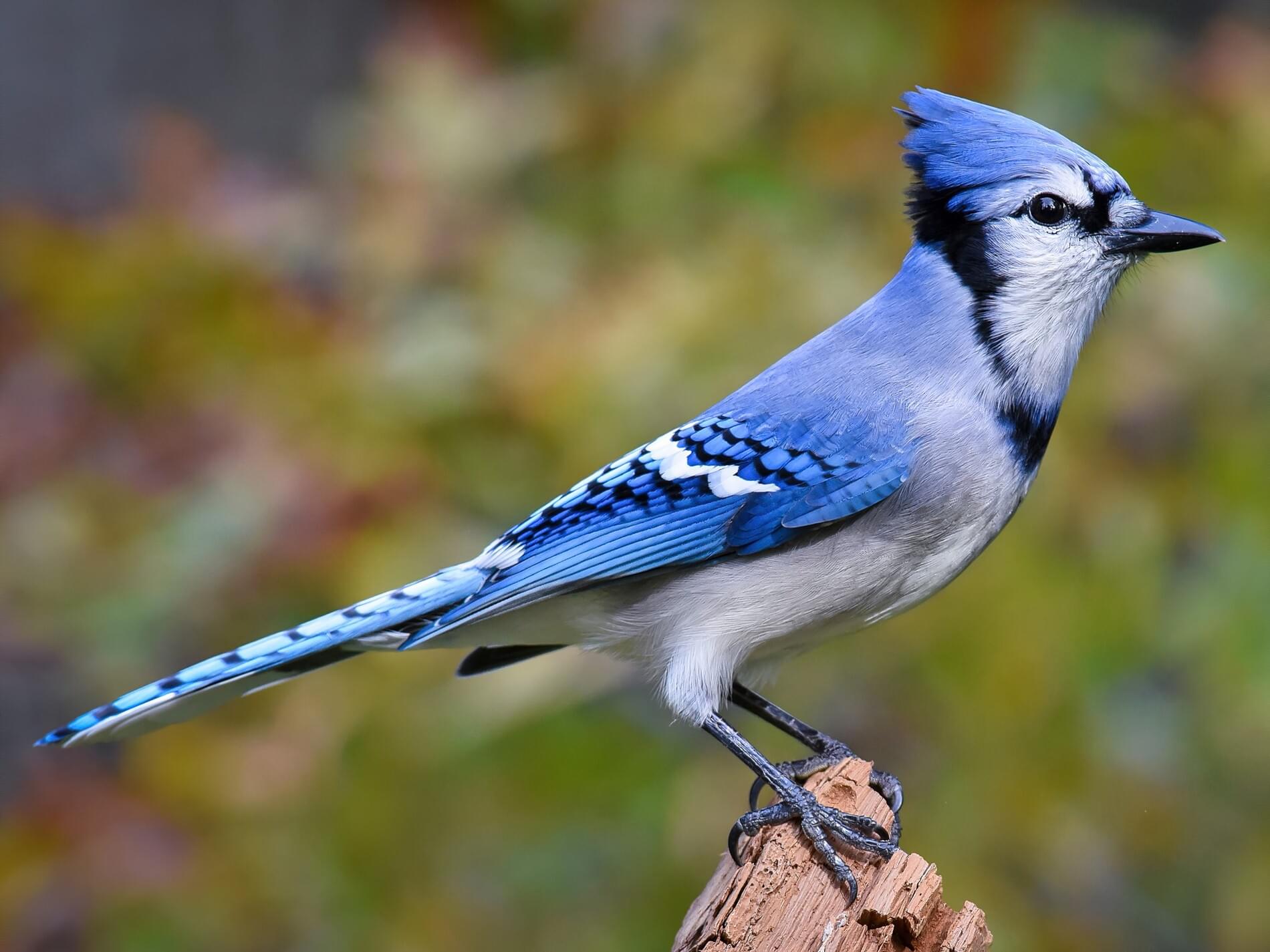Blue Jays

The blue jay, with its striking plumage and boisterous calls, is a familiar sight in North American woodlands. This intelligent and adaptable bird is a captivating presence, its vibrant colors and bold personality making it a favorite among birdwatchers.
Physical Characteristics
The blue jay’s most distinctive feature is its bright blue plumage, which covers its wings, back, and tail. This vibrant blue is offset by a black head, a white underbelly, and black markings on its wings. The blue jay’s head is also adorned with a crest of feathers that can be raised or lowered depending on the bird’s mood.
Habitat
Blue jays are found throughout eastern North America, ranging from the southern parts of Canada to the northern parts of Mexico. They prefer deciduous forests, woodlands, and suburban areas with mature trees, where they can find suitable nesting sites. Their nests are typically built in tree cavities or on branches, often high above the ground.
Diet
Blue jays are omnivorous birds with a varied diet. They consume a wide range of foods, including nuts, seeds, fruits, insects, and small animals. Their diet varies depending on the season and availability of food. During the spring and summer, they rely heavily on insects, which they hunt and catch in the forest undergrowth. In the fall and winter, they focus on nuts and seeds, which they store in hidden caches for later use.
Role in the Ecosystem
Blue jays play an important role in the ecosystem, acting as both seed dispersers and predators of insects. Their habit of caching nuts and seeds helps to spread these plants throughout the forest, contributing to the regeneration of woodlands. They also control insect populations, helping to keep pests in check.
Blue Jay Behavior and Communication: Blue Jays

Blue jays are known for their intelligence and complex social interactions. They are highly vocal birds, using a variety of calls and displays to communicate with each other. Their communication system is vital for survival, allowing them to coordinate activities, defend territories, and warn each other of danger.
Vocalizations
Blue jays are renowned for their loud, raucous calls. These calls serve various purposes, including communication within their social groups, territorial defense, and warning other birds of potential threats. They have a diverse repertoire of vocalizations, including:
- Alarm Calls: When a blue jay detects a predator, it emits a loud, harsh call, alerting other blue jays and nearby birds of the danger. This call is often described as a “jay” or “yell” and can be quite alarming to humans.
- Contact Calls: These calls are used to maintain contact with other blue jays within a flock or family group. They are typically softer and less urgent than alarm calls and may be used to signal location or intent.
- Mimicry: Blue jays are known to mimic the calls of other birds, including hawks, owls, and even human sounds. This mimicry can be used for various purposes, such as deception, warning other birds of danger, or simply for entertainment.
Social Interactions, Blue jays
Blue jays are highly social birds, living in flocks during the non-breeding season and forming pair bonds during the breeding season. Their social interactions are complex and involve a variety of behaviors, including:
- Territoriality: Blue jays are territorial, especially during the breeding season. They defend their nesting territories from other blue jays and other bird species. This territorial behavior helps ensure adequate resources for their young.
- Mating Rituals: Blue jays engage in elaborate mating rituals, including courtship displays and vocalizations. These rituals help establish pair bonds and ensure successful reproduction.
- Flocking Behavior: Blue jays form flocks, often consisting of several dozen or even hundreds of individuals. These flocks provide safety in numbers, as well as opportunities for foraging and social interaction.
Warning Signals
Blue jay calls serve as warning signals for other birds, alerting them to the presence of predators. The loud, harsh alarm calls of blue jays can be heard by other bird species, prompting them to take cover or flee the area. This behavior is known as “mobbing,” and it is a common strategy used by many bird species to deter predators.
- Hawk Alarm: Blue jays have a specific alarm call for hawks, a common predator. This call is different from their general alarm call and is specifically designed to warn other birds of the hawk’s presence.
- Owl Alarm: Blue jays also have a specific alarm call for owls, another common predator. This call is distinct from their hawk alarm call and is designed to alert other birds to the presence of an owl.
Communication Methods
Blue jays use a variety of methods to communicate, including:
- Vocalizations: As discussed earlier, blue jays have a wide range of vocalizations that serve various purposes. These calls can be used to signal danger, maintain contact, and express emotions.
- Body Language: Blue jays use a variety of body language cues to communicate, including wing posture, tail movements, and head movements. These cues can be used to express aggression, fear, or submission.
- Visual Displays: Blue jays also use visual displays to communicate, such as crest feathers, wing feathers, and tail feathers. These displays can be used to attract mates, intimidate rivals, or warn other birds of danger.
Blue Jays in Culture and Folklore

The blue jay, with its striking plumage and bold personality, has long captivated human imagination, earning a place in various cultures and folklore around the world. From ancient myths to modern literature, these birds have been associated with a range of symbolic meanings, often reflecting their distinctive characteristics and behaviors.
Blue Jays in Literature and Art
The blue jay’s vibrant colors and distinctive call have inspired artists and writers for centuries. Its presence in literature and art reflects the bird’s perceived qualities, often symbolizing intelligence, resourcefulness, and even trickery.
- In literature, blue jays have been featured in works by renowned authors like Henry David Thoreau, who described their calls as “a kind of wild laughter,” and Ernest Hemingway, who used the bird as a symbol of resilience in his short story “The Snows of Kilimanjaro.”
- In art, blue jays have been depicted in paintings by artists such as John James Audubon, whose detailed illustrations captured the bird’s beauty and anatomical features.
- In contemporary art, blue jays continue to inspire artists, with their vibrant colors and unique patterns often finding their way into abstract and surrealist works.
Blue Jays in Native American Folklore
In many Native American cultures, the blue jay holds a significant place in folklore and mythology, often embodying both positive and negative qualities.
- Among the Cherokee, the blue jay is associated with mischief and trickery, but also with wisdom and knowledge. The Cherokee believed that blue jays could communicate with the spirit world and act as messengers between humans and the supernatural.
- The Lakota people viewed the blue jay as a symbol of good luck and fortune, believing that its presence brought prosperity and happiness.
- In some Algonquin traditions, the blue jay is associated with the trickster figure Raven, representing cunning and deception.
Blue Jays in European Folklore
In European folklore, the blue jay often carries a more negative connotation, often being associated with bad luck, misfortune, and even death.
- In some European cultures, the blue jay’s call was believed to be a harbinger of death, and its appearance was seen as an omen of misfortune.
- In England, the blue jay was often called the “devil’s bird,” and its presence was considered a sign of evil.
- Despite these negative associations, the blue jay also appears in some European folklore as a symbol of intelligence and resourcefulness.
